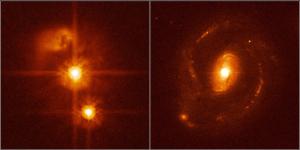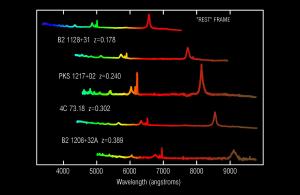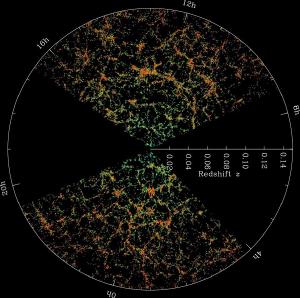Blog
Seeing Red
30 May 2014
 NASA/ESA, ESO, Frédéric Courbin & Pierre Magain
NASA/ESA, ESO, Frédéric Courbin & Pierre MagainEver since Henrietta Leavitt discovered the period-luminosity relation for Cepheid variable stars, and Edwin Hubble used her work to demonstrate the relation between the redshifts of galaxies and their distances, we’ve had a pretty good idea that the universe was expanding. Since then we’ve gathered much more evidence on the connection between redshift and cosmic expansion, including redshift observations of distant supernovae that show the universe is undergoing cosmic inflation due to dark energy. While cosmic expansion is now well established, there have been some interesting mysteries along the way. One of these involves some seemingly strange behavior of quasars.
Quasars were originally discovered as bright radio sources that appeared almost starlike. In fact the term quasar is derived from quasi-stellar radio source. We now know that quasars are powered by supermassive black holes, and are known as active galactic nuclei (AGNs). Because of their small apparent size, their distances can only be determined by their redshifts. This can be difficult to do, because the light they generate is produced near the black hole where things like gravitational lensing and gravitational redshift can occur. The spectral lines used to measure redshift can be swamped by the overall intensity of the quasar, making them difficult to analyze.
 NOAO
NOAOThen there are strange cases like AO 0235+164, which is a quasar with a faint emission line with redshift z = 0.94, but an absorption redshift of z=0.524. It was results such as these that led some to wonder if perhaps the whole cosmic expansion idea might be wrong, or at least not quite as clear as we might think. In the late 1960s, Halton Arp made a survey of irregular galaxies and noticed that for about a hundred of them there appeared to be an associated quasar. In each case the quasar had a redshift that was much larger than the associated galaxy. This led Arp to propose that perhaps quasars are objects ejected from galaxies at very high speeds. Then in the late 1970s William G. Tifft observed that redshifts of galaxies appeared to have a periodicity to them, as if redshifts were somehow quantized.1 Based upon these results, Arp and others argued that redshift cannot be due to cosmic inflation, but must be due to some intrinsic process.
 Sloan Digital Sky Survey
Sloan Digital Sky SurveyAt the time when these ideas were proposed they were worth considering. The evidence for ejected quasars was plausible, and even quantized redshift (though controversial even then) appeared to have some evidence to support it. But over the next 40 years we gathered more observational evidence. A lot more. Arp’s original quasar-galaxy connection was based upon about 100 galaxies. We now have large all sky surveys where we’ve measured the positions and spectra of a lot of galaxies and quasars. The Sloan Digital Sky Survey, for example, now has a database of more than 930,000 galaxies, and 120,000 quasars. We’ve also greatly increased our ability to analyze correlations and periodicities. What used to take months to analyze can now be done in an hour on a laptop computer.
 Tang and Zhang
Tang and ZhangWhat we found was that the ideas of Arp and Tifft don’t agree with observation. What once hinted at redshift quantization is now seen to be due to a clustering of galaxies. When large number of galaxies or quasars are analyzed, the quantization pattern fades. We’ve also found the scale at which galaxies cluster matches the clustering prediction of cold dark matter. The idea that quasars are ejected from galaxies also doesn’t match the distribution of quasar redshifts. A recent study published in the Astrophysical Journal looked at both quasar periodicity (redshift quantization) and ejected quasar using the SDSS database, and found that neither matched observation.2
And AO 0235+164? Turns out that it’s a quasar behind a closer galaxy. The emission line with a higher redshift is from the quasar, and the absorption line with a lower redshift is from the closer (foreground) galaxy. There are several similar examples, and many of them also show gravitational lensing of the quasar’s light around the galaxy.
So both of these models have been largely rejected. With nearly a million measured galaxies and quasars, it has become clear that the one model that best matches the data is an inflating universe with dark energy and cold dark matter. There are still a few researchers who strongly disagree. Their work sometimes get published in a peer reviewed journal, and that’s fine. It’s always good to have a few dissenters pushing to keep the rest of us honest.
Of course there is another pattern that has arisen, and that is the one where every time somebody writes about how quantized redshift and Arp’s non-inflationary universe model doesn’t match the data, a flood of amateur commenters hit your page to declare how wrong you are. They troll your comments and send you angry personal messages. They’ll post link after link to other papers, and demand you go through each one in detail. When you don’t accept their view they accuse you of bias and closed mindedness.
Which is why every time the topic comes up, it has astrophysicists seeing red.
Tifft, William G. “Discrete states of redshift and galaxy dynamics. I-Internal motions in single galaxies.” The Astrophysical Journal 206 (1976): 38-56. ↩︎
Tang, Su Min, and Shuang Nan Zhang. “Critical examinations of QSO redshift periodicities and associations with galaxies in Sloan Digital Sky Survey Data.” The Astrophysical Journal 633.1 (2005): 41. ↩︎